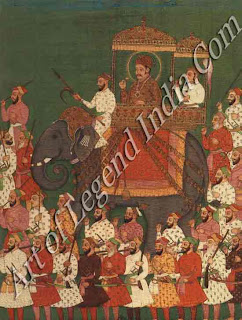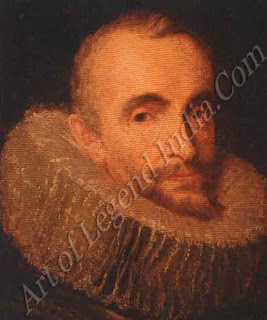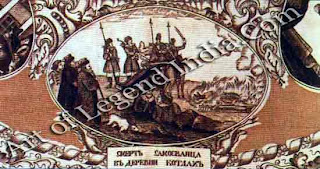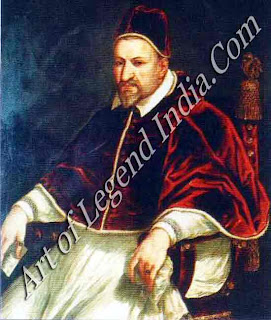Great Italilian Artist Annibale Carracci - A Year in the life 1605
Posted by
Art Of Legend India [dot] Com
On
10:08 PM
Illness
virtually ended Annibale Carracci's career in 1605; the year Guy Fawkes
attempted to blow up Parliament, Russia was plunged into her 'Time of Troubles'
with the advent of the False Dmitri, and a Spaniard wrote a tragic-comic story
that became an immediate and enduring best-seller.
The
master-mind of the 'Powder Plot' was not Guy Fawkes but Robert Catesby, a
gentleman in his early thirties who had already been active in several Catholic
conspiracies against the Protestant English state. For his most ambitious plan,
Catesby recruited three other reckless young men and brought over from the
Netherlands a tough Yorkshireman who had served for some years with the Spanish
army Guy, or Guido, Fawkes. The plotters rented a house in Westminster whose
cellar extended below the House of Lords into which Fawkes carried 20 or 30
barrels of gunpowder, placing iron bars over them to make the intended
explosion more lethal and covering them with faggots. When King James I opened
Parliament on the 5th of November, the royal family, the King's ministers, the
great peers and many of the English 'establishment' would be eliminated at a
single stroke. In the ensuing confusion, a well-armed force of Catholics
ostensibly assembled for a hunting party at a house in Warwickshire, would take
power.
To
carry out and finance this second part of their plan, the circle of
conspirators was widened and it was one of the new adherents, Francis Tresham,
who betrayed the secret. Ten days before Parliament was to meet, Tresham
contacted his brother-in-law, Lord Monteagle, a Catholic peer who would be
present at the opening. Tresham wrote: 'I would advise you, as you tender your
life, to devise some excuse to shift of your attendance at this Parliament . .
. for though there be no appearance of any stir, yet I say they shall receive a
terrible blow this Parliament and yet they shall not see who hurts them.'
Monteagle immediately reported this obscurely worded message to the chief
minister, the Earl of Salisbury. On the night of November 4th the cellar was
searched and Guy Fawkes arrested. He eventually broke down under torture and
revealed the names of his fellow-conspirators who were hunted down and either
killed or captured.
James I
was a Scot, a fact that Englishmen viewed with a mixture of interest and
centuries old prejudice. In 1605 Shakespeare was shrewdly exploiting the
interest in things Scottish by writing Macbeth, inserting suitably admiring
tableaux of the King's Stuart ancestors. During this year he also made his last
recorded appearance as an actor in Ben Jonson's new tragedy, Sejanus.
Another
notable literary event was the publication in Spain of the novel Don Quixote
(part one). Its author, Miguel Cervantes de Saavedra, had a career even more
chequered than his hero, the 'Knight of the Doleful Countenance'; he had fought
at the great battle of Lepanto against the Turks, been captured and worked as a
slave in the galleys of Algiers, and had more recently got into serious trouble
in government employ when his accounts proved unsatisfactory. Don Quixote won
immediate popularity inside Spain and was very quickly translated into several
European languages.
In the
East, power changed hands smoothly in two empires. In India, the Mogul Emperor
Akbar died and was succeeded by his son Jehangir and in Japan, the Shogun
leyasu retired in favour of his son Hidetada. But Russia hardly part of Europe
during this period was plunged into her 'Time of Troubles' by the death of Tsar
Boris Godunov in April 1605. Boris may have been poisoned, or may even have
committed suicide, since his position had become critical; Russia was stricken
by famine, and men were flocking to the banners of a pretender who claimed to
be Dmitri, the son of a former Tsar, a boy who had in fact been murdered 14
years earlier. Within a few weeks of Boris's death, his son and successor,
Fyodor II, was assassinated and 'the false Dmitri' began an inglorious
eleven-month rule as Tsar. Civil wars and foreign invasions continued during
the 'Time of Troubles' until 1613, when Mikhail Romanov became the first Tsar
of a dynasty that was to rule Russia right down to 1917.
Writer
– Marshall Cavendish
Subscribe to:
Post Comments (Atom)















0 Response to "Great Italilian Artist Annibale Carracci - A Year in the life 1605 "
Post a Comment